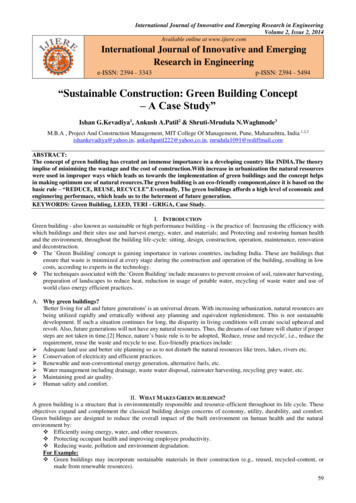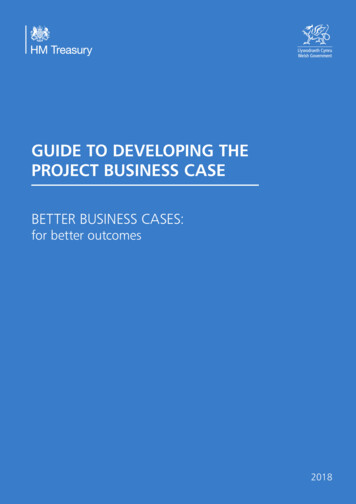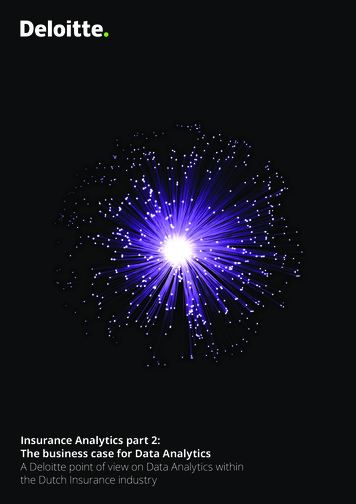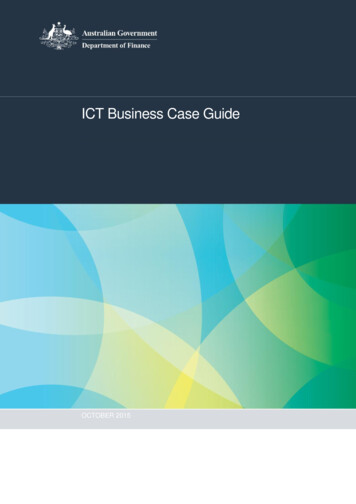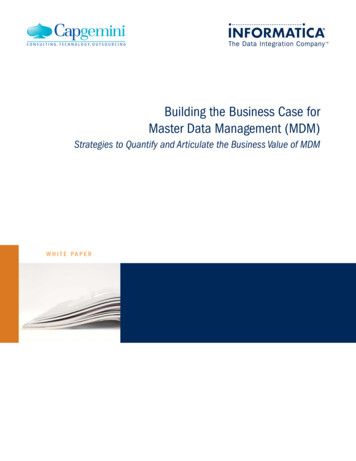
Transcription
Building the Business Case forMaster Data Management (MDM)Strategies to Quantify and Articulate the Business Value of MDMW H I T E PA P E R
This document contains Confidential, Proprietary and Trade Secret Information (“Confidential Information”) ofInformatica Corporation and may not be copied, distributed, duplicated, or otherwise reproduced in any mannerwithout the prior written consent of Informatica.While every attempt has been made to ensure that the information in this document is accurate and complete, sometypographical errors or technical inaccuracies may exist. Informatica does not accept responsibility for any kind ofloss resulting from the use of information contained in this document. The information contained in this document issubject to change without notice.The incorporation of the product attributes discussed in these materials into any release or upgrade of anyInformatica software product—as well as the timing of any such release or upgrade—is at the sole discretion ofInformatica.Protected by one or more of the following U.S. Patents: 6,032,158; 5,794,246; 6,014,670; 6,339,775; 6,044,374;6,208,990; 6,208,990; 6,850,947; 6,895,471; or by the following pending U.S. Patents: 09/644,280;10/966,046; 10/727,700.This edition published May 2011
White PaperTable of ContentsExecutive Summary . . . . . . . . . . . . . . . . . . . . . . . . . . . . . . . . . . . . . . . . . . 2Sizing Up the Master Data Challenge . . . . . . . . . . . . . . . . . . . . . . . . . . . . . 2Communicate in Business Terms, Not ‘Geek Speak’ . . . . . . . . . . . . . . . . . . . . . . . . . . . . . 3Six Key Steps to Building an EffectiveMDM Business Case . . . . . . . . . . . . . . . . . . . . . . . . . . . . . . . . . . . . . . . . . 41. Clearly Select the Business Area of Focus . . . . . . . . . . . . . . . . . . . . . . . . . . . . . . . . . . 42. Engage Key Business Stakeholders from the Start . . . . . . . . . . . . . . . . . . . . . . . . . . . . 53. Quantify the Consequences of Not Taking Action andEstablish Target Success Metrics . . . . . . . . . . . . . . . . . . . . . . . . . . . . . . . . . . . . . . . . . 74. Showcase MDM-Aware Business Applications . . . . . . . . . . . . . . . . . . . . . . . . . . . . . . . 95. Think Big, Start Small: Multidomain Extensibility . . . . . . . . . . . . . . . . . . . . . . . . . . . . . 106. Map Return on Investment (ROI) . . . . . . . . . . . . . . . . . . . . . . . . . . . . . . . . . . . . . . . . 11Conclusion . . . . . . . . . . . . . . . . . . . . . . . . . . . . . . . . . . . . . . . . . . . . . . . 12Next Steps . . . . . . . . . . . . . . . . . . . . . . . . . . . . . . . . . . . . . . . . . . . . . . . 12About Capgemini . . . . . . . . . . . . . . . . . . . . . . . . . . . . . . . . . . . . . . . . . . 13About Informatica . . . . . . . . . . . . . . . . . . . . . . . . . . . . . . . . . . . . . . . . . . 13Building the Business Case for Master Data Management (MDM)1
Executive SummaryAn effective business case for master data management (MDM) communicates the problem offragmented and contradictory data in terms that are relevant to business decision-makers. Muchlike master data itself, an MDM business case is ideally complete, reliable, and timely. This whitepaper outlines key considerations that IT professionals should keep in mind when formulating anMDM business case.Sizing Up the Master Data ChallengeBad data is bad for business. It hurts profits and productivity. It obscures opportunities for revenuegeneration and cost savings. It erodes customer loyalty, slows time to market, and introducesinefficiency and risk. As organizations seek to gain competitive advantage by effectively attractingand retaining customers, improving the quality and usability of data should be a top priority.The average company loses 8.2 million ayear from poor data quality, according to aGartner survey of 140 companies.2IT professionals recognize that MDM can quantifiably benefit the business by making master data(such as customers, products, suppliers, and assets) accurate, consistent, and accessible. Theyalso understand the gravity of the bad data problem and that, if unaddressed, it will only continueto worsen as data volumes and complexities grow.But business leaders are often oblivious to how bad data undermines performance. Many assumethat the data they use every day is sound, and those who realize the data has issues still feel thatdata management is something for IT—not the business—to worry about. C-level executives may bewary of a data infrastructure project after years of multimillion-dollar investments in ERP, CRM, andother applications.MDM is an enabling technology. Companies implement MDM to solve data challenges thatimpede the business from achieving their strategic imperatives. The business needs to be involvedbecause they are the ones who will ultimately benefit from the implementation. But to get thebusiness involved in an IT initiative, you need to build a business-focused business case. Thisis a challenge for IT professionals. Most make the mistake of preparing an MDM business casethe same way as they might respond to a technical RFP—full of technical detail and obtusearchitectural diagrams, developed solely by the IT department for the IT department. Meanwhile,the average company loses 8.2 million a year from poor data quality, according to a Gartnersurvey of 140 companies.1“If IT departments initiate an MDM initiative, they often struggle to get the business on board anddemonstrate the business value of MDM,” Gartner said. In fact, Gartner estimates that through2015, 66 percent of organizations that initiate an MDM program will struggle to demonstrate itsbusiness value.31Gartner, “Organizations Perceive Significant Cost Impact from Data Quality Issues,” August 14, 2009.2Gartner, “Organizations Perceive Significant Cost Impact from Data Quality Issues,” August 14, 2009.32Gartner, “Gartner Says MDM Is Important in a Tough Economy, and Even More Importantin a Growth Economy,” press release, December 9, 2010.
White PaperCommunicate in Business Terms, Not ‘Geek Speak’To make an effective business case for MDM, IT needs to communicate in business terms, nottechnical “geek speak.” It’s critical for IT to recognize that terms such as “MDM” and “master datamanagement” mean little to most business stakeholders. IT needs to draw a clear cause-andeffect relationship between bad data and subpar financial and business performance. IT alsoneeds to illustrate how MDM can help the business meet strategic goals by arming customerfacing teams with the complete customer data they need to: Improve productivity and profitability Drive revenue with more effective cross-sell and up-sell offers Boost customer loyalty and retention by reducing response times Reduce customer service costs by aligning service to customer value Increase operational efficiency and cash flow Streamline supply chain efficiencyRecognition of MDM as a critical business enabler is on the rise in virtually every industry. Forinstance, Gartner predicts that MDM will grow at an 18 percent compound annual growth rate overfive years, reaching 2.9 billion worldwide in 2014. Using general industry trends in your businesscase illustrates to the business that their peers are investing in MDM, and that they need to investas well.4Gartner predicts that MDM will grow at an 18percent compound annual growth rate overfive years, reaching 2.9 billion worldwide in2014.4Gartner MDM Conference London 2011Building the Business Case for Master Data Management (MDM)3
Six Key Steps to Building an EffectiveMDM Business CaseWith finite resources and competing priorities, companies cannot afford to fund every IT project.MDM evangelists should aim to develop a comprehensive, business-relevant business case thatcovers six key bases:1. Clearly select the business area of focus.2. Engage key business stakeholders from the start.3. Quantify the consequences of not taking action, and establish target success metrics.4. Showcase MDM-aware business applications.5. Think big, start small: Multidomain extensibility.6. Map return on investment (ROI).1. Clearly Select the Business Area of FocusIt’s important to recognize that your business case should differ depending on the business areain which you want to apply MDM. The three prevailing focus areas are customer-centric, enterprisecentric, and supply-centric MDM. Each of these areas has unique business issues and challenges,root causes of data problems, stakeholders, scope, and data types. Your business case should betailored to reflect those area-specific issues. Customer-centric MDM: The focus for many MDM initiatives, customer-centric MDM empowerscustomer-facing teams with a single, authoritative view of customers, the products andservices they have purchased, and their extended business and household relationships. Itenables companies to drive revenue through more effective cross-sell and up-sell, and improveprofits by providing the data required to align service levels to customer value. It contributesto customer loyalty and increases productivity of sales, service, and marketing teams byeliminating the need to search for and reconcile disparate data. Enterprise-centric MDM: Enterprise-centric MDM focuses on internal aspects of the business,such as general ledger, HR, order entry, cost codes, and assets such as buildings and contracts.Its objective is to standardize and control how the organization manages its information andinformation processes. It promotes collaboration across internal boundaries and improvesdecision-making based on master data that is consistent, timely, and accurate. Supply-centric MDM: The focus of supply-centric MDM is to generate a single view of suppliersand products across multiple divisions or lines of business. It enables greater cost efficiency inprocurement and supplier management by identifying redundancies, allowing the negotiationof volume contracts, and assessment of supplier performance across the enterprise. A singlesource of the truth for suppliers and products available across the enterprise supportsconsistency and value while reducing risk.4
White PaperMDM information landscapeMaster dataCustomersSales onsIndividualsSupply tmanufacturersSocialIndustry ®ulationInformation flow of transactionalinformation and eventsSuppliersTranslation via master dataFigure 1. Master data about customers, organizations, products, suppliers, channel partners, chart of accounts, andmore spans the enterprise landscape and can have negative financial consequences if not managed properly.2. Engage Key Business Stakeholders from the StartEffective MDM is a collaborative discipline shared by IT and business. The ideal time for IT to startcollaborating with business stakeholders is at the start of MDM business case development. Astrong business case requires in-depth input from business users and managers to enable IT toflesh out and quantify master data-related implications and benefits.Your ongoing engagement with business stakeholders should begin by identifying critical businessproblems and/or business imperatives, and by zeroing in on the role that master data plays in keybusiness processes. Your goal should be to build relationships with key business stakeholders andrecruit an executive sponsor. The best MDM business cases are usually based on both grassrootsand executive involvement.Working backwards from a business problem or a business imperative is a proven technique thatcan help you establish a baseline and the case for MDM. Scenarios that can emerge during MDMbusiness case development include:Cross-sell revenue has declined 10 percentBusiness Challenges Revenue is lost by making irrelevant product offers to existing customers. Time and money is wasted trying to acquire new customers with poor segmentation. Profits are lost, and customer retention and loyalty suffer because of the inability to alignservice levels to customer value.Root Cause Company has no single view of customers, and the products and services that customers havepurchased.Solution Create a single view of customers, products and services accessible to sales, marketing, andcustomer service.Building the Business Case for Master Data Management (MDM)5
Business Benefits Improve cross-sell effectiveness by 20 percent in a year.Avoiding Crisis-Driven MDM Improve marketing campaign effectiveness with improved segmentation.Sometimes it’s not an effective businesscase that prompts an MDM implementation,but a data-related crisis. A proactive MDMimplementation minimizes the risk of a crisisthat otherwise may be waiting to happen. Align service levels to customer value.At an 8 billion global technologymanufacturer, a C-level executive demanded alist of his company’s top 400 B2B customersby revenue to support better cross-sell andservice. He wanted it immediately, but ittook the IT team six long weeks to compilethe information. The data was strewn acrossmultiple systems and had to be reconciledby hand. Large B2B customers had multiplesubsidiaries, but it was virtually impossible tocorrelate subsidiaries to the parent in a clearhierarchy. Inability to identify account coverage gaps and conflicts, and effectively meet customerPost-crisis, the company turned to InformaticaMDM for a unified view of customer andproduct data from across business units,and to improve data-driven marketing. Thebusiness recorded a 20 percent increase inrelevant interactions with sales contacts, a 6percent increase in cross-sell, and a 5 percentincrease in repeat business.Sales rep productivity has fallen 7 percentB2B channel sales need to rise 10 percentBusiness Challenges Sales team and channel partners cannot easily determine relationships between parent andsubsidiary companies.demand.Root Cause Data on B2B customers, channel partners, and products is duplicated across multipleapplications.Solution Consolidate customer, channel partner, and product data, and map complex organizationalhierarchies to channel partner and product data.Business Benefits Eliminate coverage gaps and conflicts, improve sales and partner effectiveness, and moreeffectively meet customer demand. Increase channel sales by 10 percent.Business Challenges Sales reps spend 70 percent of their time searching for and reconciling data from customerrelationship management (CRM), sales force automation (SFA), marketing automation, andother applications. Reps are left with only 30 percent of their time to engage with customers.Root Cause Customer data is incomplete and inconsistent.Solution Deliver accurate customer data to business-user applications. Show a complete view of the customer’s business with the company as well as extendedbusiness and household relationships.Business Benefits Improve revenue per sales rep by 12 percent.6
White PaperBad data does not exist in a vacuum. One of the most vexing aspects of building an MDMbusiness case is the domino effect that bad data can trigger across multiple functional areas andlines of business. Poor data in one system can be propagated to other applications, expanding thepotential scope of impact.For instance, a service representative’s inability to see a complete customer view can hurt firstcall resolution rates. Poor service results in increased customer churn, with some of the affectedcustomers posting negative reviews of the company on social media sites. Because of thosereviews, new customer acquisition suffers, but because the cause isn’t clear, marketing is blamed.An executive scraps a marketing program that was effective and new customer acquisition fallseven further.Like the proverbial war lost because of a nail in a horse’s hoof, your company’s profitability andperformance have suffered because call center agents didn’t have a complete customer view todo their jobs effectively. Addressing the matrix of these negative consequences and leveragingreal examples from your business users’ experience should be a fundamental element of MDMbusiness case development.Make the data ‘tell a story.’ Anecdotes can provide compelling and practical examples to augmentyour business case. Encourage business stakeholders to relate instances in which suspect dataimpeded achieving an objective, and outline details in the business case. Communicate decisionmaking dilemmas that cost time and resources and introduced risk. The objective is to make thedata “tell a story” and vividly illustrate the ramifications and potential benefits in terms that aremeaningful to the business audience.“One of our strategies is to bettermeet our customer needs by makingrelevant cross-sell and upselloffers,” said a senior manager at thecompany. “We’re eliminating theneed to search for and reconcilecustomer and product data bydelivering access to detailedcustomer profiles across businessunits and channels.”These stories are an essential part of any presentation to the business, as they turn the raw figuresinto examples that the business can touch. These stories help to tie MDM into the operationalchallenges of the business and bring the case for MDM to life.3. Quantify the Consequences of Not Taking Action and EstablishTarget Success MetricsAn MDM business case must translate data into dollars. It clearly spells out the financialconsequences and opportunity costs of bad data, and the cost benefits of master data that’stimely, accurate, and accessible to the business. Your ability to quantify those consequences willdepend on the complexity of business scenarios, your collaboration with business stakeholders,and expertise you possess and cultivate at estimating financial impact.Developing sound figures requires working closely with business users and managers in finance,sales, service, marketing and other areas. It’s important to recognize that such calculations areboth art and science. Hard numbers are not always readily available, and it will pay to researchbest practices and examples of winning business cases. Illustrating a range of scenarios (fromminimum to maximum impact) helps to make clear the scope of the problem while acknowledgingthe inherent limitations of the process.At the end of the process, it is the business that ultimately owns and commits to these metrics.The process of determining the metrics and the goals for each is critical for the development ofthe business case. A side benefit of this process is that it’s not framed as “MDM”—it’s specificallyframed in terms and metrics of the business.Building the Business Case for Master Data Management (MDM)7
Figure 2 roughly illustrates the types of metrics and financial impact that could be measured foran MDM initiative aimed at generating a single customer view. Such data should be supported bya detailed explanation of the basis for calculation, assumptions used, and timeframes of impact.This calculation boils down to the “cost of doing nothing” and may be extrapolated over a periodof years.Costs of Bad Customer DataMinimumMediumMaximumLost revenue opportunities 190,000 421,000 912,000Increased customer churn 221,000 417,000 734,000High call center inquiries 98,000 136,000 229,000Mistargeted marketing spend 76,000 188,000 302,000Billing and invoicing errors 41,000 67,000 82,000Sales rep inefficiency 134,000 233,000 355,000IT point-to-point maintenance 99,000 154,000 198,000Total Costs (per year) 859,000 1.62M 2.81MFigure 2. An example estimating the impact of bad customer dataFigure 3 provides a high-level example of the cost benefits of customer-centric MDM by keymetrics, again using a range from minimum to maximum. It may also be extrapolated over a periodof years, accounting for variables that may be introduced over time.Benefits of Customer MDMMinimumMediumMaximumImproved cross-sell 255,000 513,000 1.1MGreater customer loyalty 264,000 489,000 965,000Reduced call center costs 127,000 288,000 451,000Targeted marketing conversions 98,000 212,000 350,000Reduced billing disputes 75,000 100,000 136,000Better sales rep inefficiency 177,000 344,000 501,000Better IT efficiency 145,000 199,000 304,000Total Costs (per year) 1.14M 2.15M 3.81MFigure 3. An example estimating the positive impact of customer MDMThe qualitative benefits of improved decision-making. Though the business will agree thatreliable, consistent data supports smart decisions, quantifying the impact is seldom easy.Improved decision-making is one of the “soft” benefits of MDM that needs to be addressed ina business case, even if hard numbers cannot be associated with it. It can help to identify badbusiness decisions and determine whether bad data was a culprit. Was the information used forthe decision complete? Did it overlook a critical consideration that could have been revealed byan unused data source? Did the data include errors that prompted the bad decision? Thoughinstances at your company are preferable, external examples identified through research can makethe point as well.Revealing hidden problems and mitigating risk. Though it cannot be quantified, your businesscase should make clear that MDM is likely to uncover business-impacting data problems thatwould otherwise go undetected. Particularly in large global companies, it’s not uncommon fora small data anomaly in pricing, production, or other data to cause needless costs or revenueleakage. An ongoing MDM program and associated data governance enables a company toproactively monitor for such hidden problems and mitigate the risk posed by bad data.8
White Paper4. Showcase MDM-Aware Business ApplicationsYour business case should clearly depict the practical utility that an MDM system offers tobusiness users. Business leaders tend to think of MDM as a back-end infrastructure solution but,in fact, the best MDM technology gives business users hands-on access to and control of masterdata in the applications they use every day.For instance, new technology called Informatica Data Controls—part of Informatica MDM—enablesyou to make CRM, ERP, and other enterprise applications “MDM aware.” This means that nontechnical business users are presented with consolidated, reliable multidomain master data withintheir preferred applications, be they salesforce.com, Oracle, SAP, Siebel, or others.Let’s say a salesforce.com user wants to establish an account for a new customer called EG. Theproblem has been that CRM applications don’t know that the same company, by another nameof Electric General Company, already exists in the database. The sales rep ends up establishing anew account for a company that’s already a customer, which creates two problems: One, the rephas no visibility into potential cross-sell opportunities within EG/Electric General Company. Two, aduplicate account will cause issues down the road, such as inability for a sales manager to viewtotal sales for a single company with two names.Integrated with salesforce.com, Informatica Data Controls detects the duplicate and informs thesales rep before the EG account is created. An MDM-aware application will also present to thebusiness user: Customer transactions and interaction histories Complex hierarchies of B2B parents and subsidiaries Customers’ extended business and family relationships Third-party demographic/firmographic data from providers like Acxiom Real-time data changes (e.g., large customer transfer between accounts) History of data changes (who changed what when; useful for compliance)The ideal business case will highlight how the latest MDM technology can empower front-linesales, service, operational, supply chain, and other staff with information that can improvebusiness performance. In effect, MDM-aware applications promote proactive usage andgovernance of multidomain master data among business users without the need to learn and usea specialized MDM application.Building the Business Case for Master Data Management (MDM)9
Acquire & Retain Customers by Enabling CRM with Trusted & Complete Customer DataFigure 4. Informatica MDM delivers master data to common business applications.5. Think Big, Start Small: Multidomain ExtensibilityChances of funding increase if your MDM business case targets a well-defined and focusedarea that stands to deliver rapid payback. However, business case development presents theopportunity to articulate a longer-term strategic vision for how MDM can be extended acrossmultiple domains of the enterprise.If, for instance, you initially target customer data management, be sure to map out a case formultidomain MDM extensibility—applying MDM to enterprise operations, supply chain, andproduct management, or across separate lines of business of geographic locations. You shouldalso highlight the readiness that MDM offers in rapidly consolidating and reconciling data indifferent formats across multiple systems in the event of a merger or acquisition.This multidomain extensibility aspect of the business case should outline the cost-effectivereusability of an MDM platform and make clear that the initial investment is not a one-off sunkcost. Today’s best MDM technologies take a platform approach that enables MDM architects tobuild from the bottom up, beginning with a flexible, foundational data model, followed by businesslogic, and finally the user interface. This differs from the top-down application approach, in whichthe order is reversed and a fixed data model is used.As a result, the platform approach offers greater long-term cost efficiency, as the data model maybe repurposed without the time and costs invested in the original implementation. An additionalbenefit is the lower ongoing maintenance cost of a platform-based MDM solution, compared tosilos of MDM applications.10
White Paper6. Map Return on Investment (ROI)Some financial managers may zero in immediately on one metric—the ROI that your MDM projectpromises to deliver. Particularly for decision-makers weighing competing proposals, ROI provides acommon denominator by which value can be judged and funding decisions made.Like the rest of your business case, your ROI calculations should be in the language that yourorganization’s financial and business leaders speak. Work with your business-side contacts tounderstand the data and documentation they expect in a sound ROI calculation. Look to externalsources for how-to guidance and best practices on the nuances of ROI models.At a high level, your ROI calculation will weigh the expected quantified benefits of an MDMsolution against its costs in software licensing and maintenance, servers, implementation,consulting, training, and potentially others. If your benefit is 2 million and your costs are 1million, then your ROI is 100 percent. As with your calculation of benefits, ROI may be presentedin a framework of minimum, moderate, and maximum to account for various contingencies andunknowns. It should also annualize payback over a period of years.But you may find that your company doesn’t view ROI quite so simplistically, and prefers to judgeinvestments based on internal rate of return (IRR), which requires calculating net present value(NPV). Both of these measures incorporate additional variables into the equation (such as time,risk, discount rates, and more). Due diligence into your company’s preferred means of measuringvalue will pay off with a business case that communicates your proposal in terms relevant todecision-makers.Building the Business Case for Master Data Management (MDM)11
ConclusionBad data will never cure itself. Unchecked, it will continue to compromise business performancethrough lost opportunities, high operational costs, and subpar customer loyalty. MDM enablescompanies to empower the business with trusted and complete data to improve businessprocesses and enable strategic imperatives. Because of this, it requires a different business casethan most IT professionals are accustomed to building. It requires a business-focused businesscase. With a thorough business case, MDM advocates have an opportunity to turn vision intoaction and drive quantifiable bottom-line benefits for their organizations.Next StepsCapgemini and Informatica offer introductory workshops to help you assess the master dataissue at your organization and lay the groundwork for an effective business case. Additionally,services are available to assist you in MDM business case development, applying best practices indiscrete functional areas, profiling data to assess its weaknesses, and other areas. An introductoryengagement can help get you started on strategizing on the business focus area and scope of anMDM implementation, and generate initial cost estimates needed to determine the overall value ofthe investment.12
White PaperAbout CapgeminiCapgemini, one of the world’s foremost providers of consulting, technology and outsourcingservices, enables its clients to transform and perform through technologies. Capgemini providesits clients with insights and capabilities that boost their freedom to achieve superior resultsthrough a unique way of working, the Collaborative Business Experience . The Group relies on itsglobal delivery model called Rightshore , which aims to get the right balance of the best talentfrom multiple locations, working as one team to create and deliver the optimum solution forclients. Present in 40 countries, Capgemini employs around 110,000 people worldwide. Moreinformation is available at www.capgemini.com.About InformaticaInformatica Corporation (NASDAQ: INFA) is the world’s number-one independent provider of dataintegration software. Org
Informatica Corporation and may not be copied, distributed, duplicated, or otherwise reproduced in any manner without the prior written consent of Informatica. While every attempt has been made to ensure that the information in this document is accurate and complete, some






